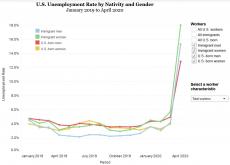Immigrants’ U.S. Labor Market Disadvantage in the COVID-19 Economy: The Role of Geography and Industries of Employment
While the nation’s economic outlook remains uncertain due to the unpredictable course of the pandemic, most general economic indicators are improving, albeit slowly. The total U.S. unemployment rate fell from a peak of 14.4 percent in April 2020 to 5.7 percent in July 2021. But the sharp job losses and subsequent partial rebound have been spread unevenly across the country, affecting different populations, regions, and economic sectors differently.
During the worst of the pandemic-induced economic downturn, immigrants experienced much higher unemployment rates than U.S.-born workers. But by July 2021, immigrant unemployment had fallen below that of U.S.-born workers. Still, immigrants are not particularly well-positioned to take advantage of the economic recovery, given their concentration in industries and regions of the country with still-elevated unemployment rates.
This issue brief uses monthly data from the U.S. Census Bureau’s Current Population Survey (CPS) to examine the extent of job losses and shifts in employment patterns among immigrant and U.S.-born workers from mid-2019 to mid-2021. In particular, it looks at how foreign- and native-born men and women have fared in different industries and parts of the country.
1 Introduction
2 Changes in the Number of Workers and Their Employment Levels
3 Trends across U.S. Geographic Regions
4 Trends across Major Economic Sectors
5 Conclusion



